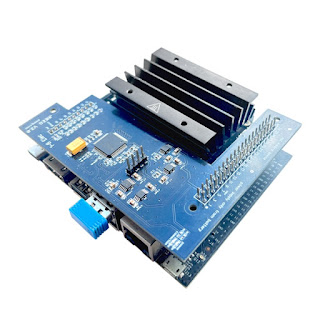JNEEG shield for Jetson Nano for real-time EEG signal processing with deep learning The article presents an accessible route into the field of neuroscience through the JNEEG device. This device allows converting the Jetson Nano board into a brain-computer interface, making it easy to measure EEG, EMG, and ECG signals with 8 channels. With Jetson Nano is possible use deep learning for real-time signal processing and feature extraction from EEG in real-time without any data transmission. Over the past decade, the proliferation of artificial intelligence has significantly impacted various industries, including neurobiology. The integration of machine learning techniques has opened avenues for practical applications of EEG signals across technology sectors. This surge in interest has led to the widespread popularity of low-cost brain-computer interface devices capable of recording EEG signals using non-invasive electrodes. JNEEG device demonstrates satisfactory noise levels and accuracy
Сообщения
- Получить ссылку
- Электронная почта
- Другие приложения

Dear Friends, If you dream about Deep learning and EEG for real-time in one easy use device than this device can be interested for you) 🌟🌟 Use deep-learning for signal processing and feature extraction in real time for EEG with new JNEEG device! JNEEG shield for Jetson Nano to read EEG, EMG, and ECG signals. In other words, the JNEEG shield can convert Jetson Nano to brain-computer interface Device already available in the market with our partner Elecrow https://pieeg.com/jneeg/ # EEG hashtag # BCI hashtag # neuroscience hashtag # JNEEG hashtag # JetsonNano hashtag # Nvidia
8 channel Open-source Raspberry Pi shield that measures EEG, EMG, and ECG bio-signals to provide an Easy way to the neuroscience world
- Получить ссылку
- Электронная почта
- Другие приложения
PiEEG is an open-source Raspberry Pi shield that measures biosignals such as those used in electroencephalography (EEG), electromyography (EMG), and electrocardiography (ECG). PiEEG is versatile, easy to work with, and compatible with different types of electrodes. Best of all, it was designed to be usable by anyone. To begin measuring bio-signals, all you need to do is connect the electrodes and run a Python script. Applications include gaming, entertainment, sports, health, meditation, and more. PiEEG is not a medical device and has not been certified by any government regulatory agency for use with the human body. You are fully responsible for your personal decision to purchase this device and, ultimately, for its safe use. Features & Specifications Compatible with Raspberry Pi 3 or 4 4 or 8 channels for connecting wet or dry electrodes Data transfer via SPI protocol with a frequency from 250 SPS to 16 kSPS and a resolution of 24 bits per channel Programmable signal gain: 1, 2
- Получить ссылку
- Электронная почта
- Другие приложения
PIEEG: Turn a Raspberry Pi into a Brain-Computer-Interface to measure biosignals. arXiv:2201.02228 https://www.researchgate.net/publication/357698587_PIEEG_Turn_a_Raspberry_Pi_into_a_Brain-Computer-Interface_to_measure_biosignals_arXiv220102228 his paper presents an inexpensive, high-precision, but at the same time, easy-to-maintain PIEEG board to convert a RaspberryPI to a Brain-computer interface. This shield allows measuring and processing eight real-time EEG(Electroencephalography) signals. We used the most popular programming languages-C, C++ and Python to read the signals, recorded by the device. The process of reading EEG signals was demonstrated as completely and clearly as possible. This device can be easily used for machine learning enthusiasts to create projects for controlling robots and mechanical limbs using the power of thought. We will post use cases on GitHub (https://github.com/Ildaron/EEGwithRaspberryPI) for controlling a robotic machine, unmanned aerial vehicle, a